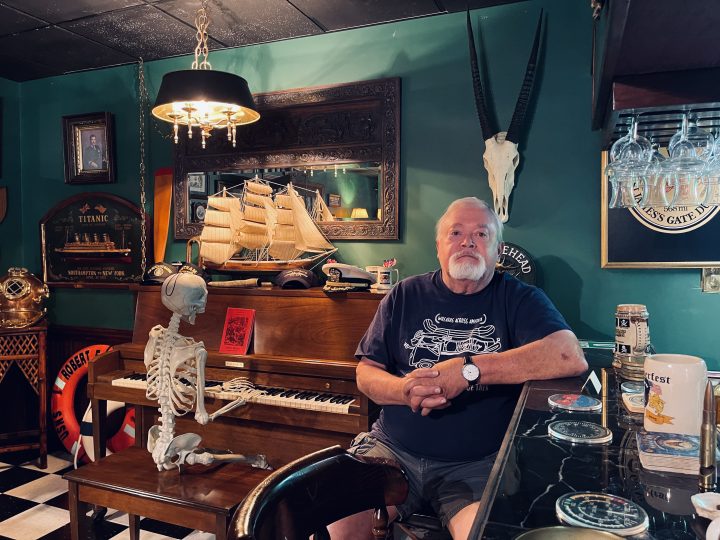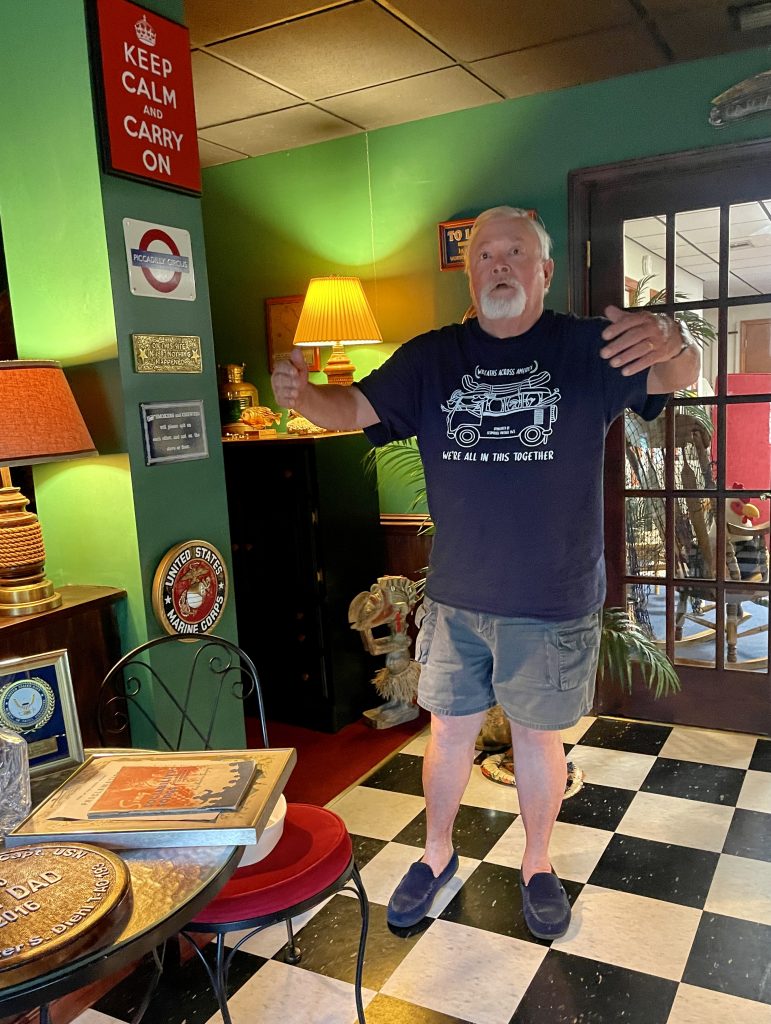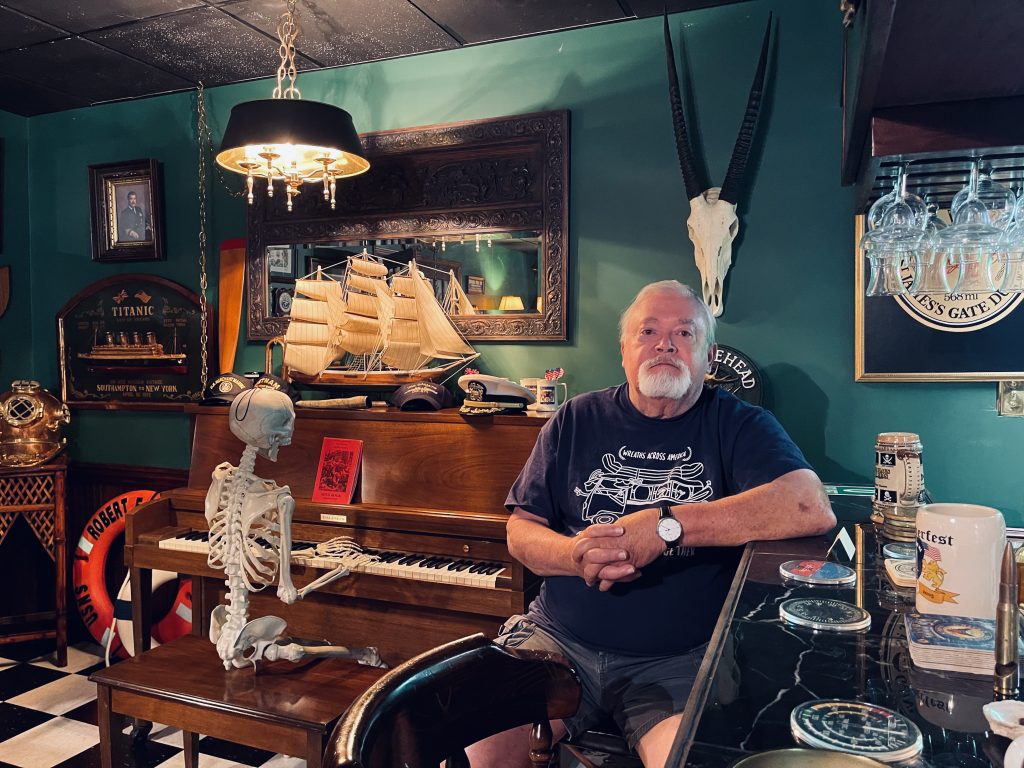
Strut the Hooch parade founder, musician, educator, author U.S. Navy veteran, bon vivant
How would you describe the Strut the Hooch parade to the uninitiated?
“As a kind of giant Mardi Gras parade.”
Is it hard to instill that Mardi Gras vibe in Columbus?
“No. I’ve found people who want to have a lot of fun and show off their personality and their creativity.”
What are some of the most creative costumes you’ve seen?
“I had 10 friends one year do a roller-coaster. We’ve had body floats. The LaGrange Mardi Gras krewe had a big float. Costumed pets. All kinds of strange things.”
How many years have you been doing Strut the Hooch?
“This will be the seventh year. We missed last year because of the virus. I started it in 2015.”
How would you describe the evolution of the parade?
“Slow but sure.
The first year, I had some people bail out on me. We only had 26 people. I’m still amazed I had talked Richard Bishop into doing not only an event, but a weird concept. But at the end, the people that were in it were excited. And the people that saw it said, ‘Boy! That was really cool. What was that?’ So I knew I had to do some branding.
I was afraid Richard would say, ‘Man, this just isn’t working.’ But he said, ‘Yeah! We’ll do this every year.’ He told me, ‘When we started Market Days, we had 8 very reluctant vendors. Now it stretches 4 blocks.’
So the second year we had 100 people. In the third year, we had 200. Fourth year and fifth year, we had 200.But those last two years, we got rained on heavily; we would have easily had 350 or more. Still, to see 200 people prancing in the rain, from a two-and-a-half year old girl to a 84-year-old woman driving a golf cart recklessly.”
What gave you your start as a musician?
“High school band. And my mother had a lot of Guy Lombardo records, so I know all the tunes and words to those 30s, 40s and 50s songs. Then I played in the band at Auburn.
I’m a drummer. Taught myself how to play tuba in high school — so I’m still a beginner, but I enjoy that. I do a lot of spoons and washboard with bluegrass groups.”

Music is obviously still a big part of your life. You have a professional-grade studio here.
“I built that to have people over. We’ve had some really great things. We’ve had 2 what I call ‘pick and grins’ where I had all my guitar, mandolin and banjo player friends come and join in.
Recently, I had a female singer do a sing-along with drums, piano, guitar, sax and trumpet. It was great. Had my friend Georg Corradino, who is 91, play tenor sax. Also had Kevin Vannoey, who was one of my band students at Central High School in the early ‘70s, playing tenor sax. And Daniel WIndsor, a dentist from Phenix City, who plays fantastic piano.”
You’re also a published author.
“I’ve written 5 children’s books. I sell 1 about every other month, when I get a check from Amazon for $14
I’m trying to finish up a book of my silly pomes — pomes, not poems — called Brain Biscuits.
My influences are Edward Lear, Ogden Nash, Dr. Seuss, and Charles Osgood – whose influence was Dr. Seuss. I even have a letter from Osgood. I sent him a fan letter one time and stuck some of my poems in there. Forgot about it, and a couple of months later, I got a personal letter from him, referencing my pomes.
I’m trying to wrap that up in the next month or so and get it sent off to the publisher.”
Why do you call them silly?
“I call them pomes instead of poems because, when I went to get a domain name for pome gnome, somebody already had it —but they weren’t using it. So I thought, ‘Mine are silly and whimsical and observations of life, just fun. So I decided to stick with pomes.”
What other writing projects are you working on?
“I‘m working on what I hope will become a coffee table book called The Emergence of Columbus.
A lot of people have written histories of Columbus. This is also a history, focused on historic preservation.
The people early on who had the vision and the courage and the determination to bring us not only what we have today in terms of all the museums, the whitewater, and everything downtown, but who we are. Because when I first came here, Columbus didn’t have a real sense of self. And now we do. We have a rich cultural history.
So this is people like Bill Turner, Harry Kaminsky, Rozier Dedwylder, Frank Martin, Buddy Nelms, and so forth. Very few in the beginning but eventually a lot of people who brought us here. I’ve interviewed 15-20 people, Virginia Peebles, Janice BIggers, Clason Kyle, Billy Turner, Ed Kinner, who was engineer on the whitewater project, General Carmen Cavezza.
People think all this great stuff has happened in the last 5 years but it’s been 60 years in the making.”
What do you think is responsible for creating that sense of self?
“I asked Mat Swift — who is my first contact on this project — about that lack of sense of self, and he said, ‘I know exactly what you mean. When do you think that changed?’
I said, ‘I guess the Olympics. He said, ‘That’s what I think.’
We got it on a fluke, really, because Cobb County had already sewn it up. But when they had their first SPLOST (Special Purpose Local Option Sales Tax), which a new Georgia law allowed, it didn’t pass the same time as ours did. BiIl Turner insisted Carmen Cavezza head that effort up and the rest is history.”
Is it fair to say you march to the beat of a different drummer?
“In first grade, my teacher sent me home with a note that said, ‘Little Stevie appears to be marching to a different drummer.’ Which is prophetic, because I became a drummer.”
On a daily, get-up-and-go basis, what inspires you?
“I’m a little over a year from 80 and I got two more lifetimes of stuff I want to do. And you don’t know when the bus is going to hit you.
I think the meaning of life is a giant homework assignment. The lesson is love and part of our purpose — besides trying to take care of each other, which we have not done, since time began — is to create. Whatever it is. Whether it’s a great symphony or a silly poem.”

BONUS CONTENT: Listento full-length interview by Electric City Editor Frank Etheridge with Steve Scott inside his home. 8.18.2021
Age: 79
Hometown: Fairhope, Alabama
Education: Bachelor’s in Music Education, Auburn University; Master’s in Music Education, Auburn;
Master’s of Business Administration, Columbus State University
Professional background: “I’ve done everything besides make ping-pong balls and embalm people.”
Best lesson for civilian life you learned in the Navy: “Always have a plan, work your plan, and be prepared for any contingencies.”
Favorite Musical Instrument: “Besides drums, I love French horn. I think it’s beautiful. And it has such a range — 4 octaves.”
Best part of being married to an artist: “Lots of energy and ideas. Never a dull moment.”
Favorite local restaurant: Uptown Vietnamese
Best collegiate marching band (besides Auburn): Florida State University
Worst change in Columbus over the past 25 years: Crime
Best change in Columbus over the past 25 years: “Finding ourselves.”

